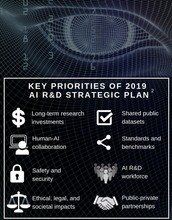June 24, 2019 — Allyson Kennedy — NSF
In the summer of 1956, a small group of computer scientists and mathematicians converged on Dartmouth’s campus to define a burgeoning field of research they called “Artificial Intelligence,” or AI. Six decades later, advances in robotics, autonomous vehicles, and machine learning continue to push the boundaries of how we define AI and its translation across nearly every sector of society. These benefits are due, in part, to the decades of long-term Federal investments in fundamental AI research and development. Some of CISE’s investments in AI have led to breakthroughs in the way we track and predict disaster damage, optimize medical procedures, teach computational thinking, and understand algorithmic fairness and reliability.
But the AI landscape is continually evolving. Globally, GDP is expected to increase by $15.7 trillion, making investments in education and training opportunities essential in preparing the American workforce for a new era of AI. Indeed, 72% of industry executives believe that AI will be the most significant business advantage of the future. However, there is still much scientific work to do. Researchers today continue to grapple with how to achieve general intelligence, in which AI systems are capable of thinking like humans and building on prior experiences to tackle new tasks. Similarly, scientists are working to create intelligent machines that are fair and trustworthy, and can clearly explain their decisions to users to improve human-computer collaboration.
These, and other grand challenges, have made technological advancement in AI a national priority. Earlier this year, the White House issued the Executive Order on Maintaining American Leadership in Artificial Intelligence and launched the American AI Initiative, an all-of-government strategy to promote and protect the AI research enterprise in the U.S. In line with this vision, Friday marked the release of the 2019 Update to the National AI Research and Development (R&D) Strategic Plan. The nearly 50-page document outlines eight strategies for advancing AI R&D. Seven of these strategies have continued from the first strategic plan published in 2016. There is one notable addition: an imperative to create sustained and strategic public-private partnerships. The unique government-university-industry ecosystem in the U.S. is ideal for leveraging resources, data, and expertise to advance scientific innovations. AI research, in particular, can benefit from such partnerships due to the inherent cross-sector nature of the field; the flow of people, ideas, and innovations across government, academia, and industry not only enhance domestic economic benefit, but also position the country as a global leader in this space.
NSF’s Computer and Information Science and Engineering (CISE) directorate has long recognized the pivotal role of collaboration in advancing innovations in computing and information science, recently partnering with Amazon, Partnership on AI, and DARPA to pursue research challenges in AI. Late last month, CISE led a convening of stakeholders across U.S. government, industry, and non-profit sectors to assess the current and future state of AI research and development.
Join us as we envision a future in which cross-sector collaboration advances fundamental research and education in AI and addresses society’s largest challenges. From the creative minds who must ideate and innovate new and existing technologies, to the trained educators who must prepare a diverse and technologically-savvy workforce, to the organizations supporting these efforts, advancing the future of AI will take all hands on deck.
The National Science Foundation (NSF) is an independent federal agency that supports fundamental research and education across all fields of science and engineering. In fiscal year (FY) 2019, its budget is $8.1 billion. NSF funds reach all 50 states through grants to nearly 2,000 colleges, universities and other institutions. Each year, NSF receives more than 50,000 competitive proposals for funding and makes about 12,000 new funding awards.

Useful NSF Web Sites:
NSF Home Page: https://www.nsf.gov
NSF News: https://www.nsf.gov/news/
For the News Media: https://www.nsf.gov/news/newsroom.jsp
Science and Engineering Statistics: https://www.nsf.gov/statistics/
Awards Searches: https://www.nsf.gov/awardsearch/


